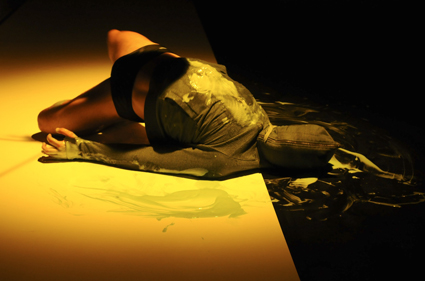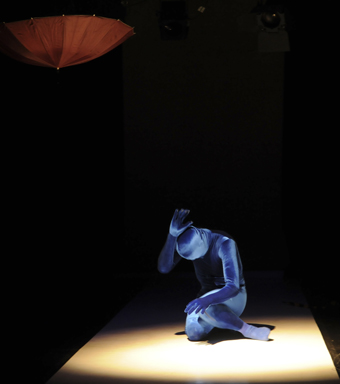underwater anxieties
pauline manley: dean walsh, fathom

Dean Walsh, Fathom
photo Heidrun Löhr
Dean Walsh, Fathom
DEAN WALSH HOLDS THE AUSTRALIA COUNCIL DANCE FELLOWSHIP FOR 2011-2012, HIS ARTISTIC TENACITY REWARDED WITH INSTITUTIONAL SUPPORT. IN WALSH’S OWN WORDS, FATHOM IS AN EXPERIMENT AND A SMORGASBORD OF IDEAS: A REFLECTIVE MOMENT IN A TWO-YEAR PROCESS.
Walsh is an artist with important things to say. Dance can have a timid political voice but in Fathom Walsh seeks to connect movement theatre with the wider world and a political hot potato: the health of our natural environment. The relationship is not always comfortable or even clear, but the motivations are intense and passionate.
The black box stage is strung with striped tape, cordoned off like a scene of violence. Hanging hooks hold bags of green liquid horror. Implicit in this pre-set image is the thematic destruction that feeds Fathom: “not only was the bush gone, but the entire creek and swimming hole had been filled in. In its place is street after street and house after identical house: suburbia. No gum trees in sight” (program note).
Sitting to one side is a yellow man in a large blue bucket. He has no face. He fishes as a watery soundscore floats. His fishing pole creates a gentle arc against the lines of striped tape. As he stands his upper back leans, curving like the fishing pole. He dips as sound flutters.
This opening scene is intensely aesthetic: shape, colour and line dominate action. While it does become more alive with movement, what remains resilient in Fathom is image. In a series of episodes that fluctuate in tone, intensity and personality, it is be colour, lighting, costume, screen and apparatus that provide the performative punch. In this way Fathom does not cast itself so much as movement theatre or a reflection of the underwater world, but as a series of aesthetic events.
Walsh sits in a spotlight, his hands cast the colour of lobster. He pulls at the featureless face of the masked fisherman, trying to breathe, gulping for air. He twists and pulls and strips away the yellow face. A nightmare vision, this stretchy striptease is impacting, but we are rushing on with no time to linger on matters of strangulating angst.
Liquid lounge music elicits a more fluid dance. Walsh’s body has a signature written in his open joints, raised chest and extreme flexibility. Blown by undercurrents, his soft release is pleasure felt and pleasure communicated, but this oceanic movement moment is fleeting. He continues to strip away the costume. Fingers wave, wiggling his body into violent convulsions as his skin is lit lobster red again. An umbrella turns man into mollusc. He strips again. Silence and breathing become vocal snorts, rasps, sighs and grunts. Now in black he walks tortured down a white runway. He strips again.
Whale sounds herald a comic turn. As he searches for the lost beasts a baffling simian comedy briefly unfolds. He strips again. Now down to his underwear. Text moves down the screen, making this dense journey lecture-like: sometimes spelling out that which is not apparent, but sometimes too complex to grasp, sometimes interfering.

Dean Walsh, Fathom
photo Heidrun Löhr
Dean Walsh, Fathom
Driving trance music catches Walsh in a net before silence once more heralds a return to comedy. With a netted head atop a lurid green dress he dances a camply distorted ballet. I no longer know where I am. The screen image tells me I am at a beach polluted with plastic shopping bags. He caresses himself and strips again.
Colour again. Spinning bags of slimy sputum drip lines of gunk into artistic shapes on the floor. Underneath Walsh sits whimpering amongst the freshly fetid smell. He wails as he flails and slides to escape the glossy mess. He gasps into a surface made beautifully smooth, slides into glides made possible by oily ground. These lines of putrid green become luminescent. The stage is smeared with the muck of humanity and, from this defiled space, the performer leaves, opening a door of light, to enter a cleaner world.
Fathom is baffling. It is crowded with ideas and images: some patently clear, some obtuse. This must be forgiven in an ‘experiment.’ The aesthetics of light, colour and form are the work’s most vital assets. The choreography, only momentarily liquid, seems to reside outside the rhythms of the environment it seeks to embody, with the visual art emphasis yielding flatness rather than depth. But Fathom, in this incarnation, is definitely the promised smorgasbord of ideas.
Fathom, devisor, choreographer, performer Dean Walsh, advisor Paul Selwyn Norton, lighting Clytie Smith, costumes Rebecca Bethan Jones, sound editor Kingsley Reeve, video Martin Fox; Performance Space, Carriageworks, Sydney, May 19-22
RealTime issue #104 Aug-Sept 2011 pg. 7






